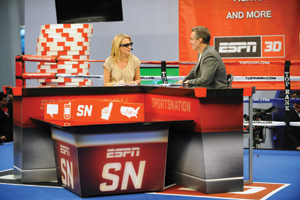There was little doubt last week that 3-D TV, the craze of this event two years ago, has given way in talk and hype to a dizzying run of “smart” devices seeking to employ human interactions such as gesturing and voice recognition.
So while “smart” was the constant marketing buzzword of CES this year, hardware manufacturers and content programmers spent the week trying to convey the idea that 3-D TV is still a, well, smart idea for consumers.
On one level, sales of 3-D TVs are tracking comparatively well ahead of the early days of high-definition television. More than 10 million U.S. homes are expected to have a 3-D-enabled set by the end of this year.
But a series of early hiccups has fueled a widespread notion that 3-D TV is simply a fad, soon on its way out. Among the mistakes were the unpopular rollout of expensive and bulky active-shutter glasses and distribution of poorly produced, headache-inducing 3-D programming.
Manufacturers and networks spent last week trying to undo the damage and outline a more-integrated marketing message in which 3-D TV is simply one facet of an overall modern home-entertainment experience. Companies such as LG, Panasonic, Sony and Samsung each unveiled TV sets with much-higher-quality 3-D resolution than before and that, in many instances, rely on passive-shutter glasses that are far cheaper, lighter and more fashionable than their predecessors.
 |
ESPN used the event to stage its first studio show produced in the 3-D format.
Photo by: KOHJIRO KINNO FOR ESPN IMAGES
|
ESPN, staging its own CES booth for the first time, spent the week beating the 3-D TV drum with a series of high-profile programming efforts, including an on-site “SportsNation” episode that represented the network’s first studio show produced in the enhanced format. Panasonic and NBC Olympics also got into the act, announcing plans for more than 200 tape-delayed hours of 3-D coverage of the 2012 Summer Games from London.
“Frankly, I was much more discouraged about four years into the HD conversion, where progress had sort of stalled there for a while, than I am now at this stage of the 3-D development,” said Bryan Burns, ESPN vice president of strategic business planning and development. “We’ve seen this story play out before, and the fact remains that we’re tracking ahead with 3-D [compared to] where we were at a comparable point for HD.”
Beyond “smart,” the other oft-repeated talking point at this year’s CES was a “chicken-and-egg scenario” between 3-D TV manufacturers and programmers. Networks in many instances are waiting for a higher installed base of sets before pushing the envelope on 3-D programming — but manufacturers and retailers can’t sell sets without consumers having content to watch on those sets.
Breaking that cycle will rest significantly on bringing production costs down. 3-D TV shows to date have been prohibitively expensive to make, generally at least twice the cost of the same material in 2-D. But networks, including ESPN, more recently have pursued an integrated “5-D” production model in which a 2-D feed is extracted out of the 3-D feed. The blended model removes the need for separate 2-D and 3-D production trucks and crews.
“We’re now in a phase where we’re concentrating more on the economics,” said Vince Pace, co-chairman of the Cameron Pace Group, which produced the hit film “Avatar” and has worked with several sports entities. “We’re going to get the cost of 3-D production down to the cost of 2-D production. It’s natural that we will progress to a state where the economics will scale up to fill this black hole of content that exists.”
The other task will be to recalibrate consumer expectations. Just as 3-D TV was starting to become widely available, “Avatar” was released to theaters. The hit film took more than four years to make, but fans have expected even live 3-D TV programming to look as good as the film content. Programmers also must find a way to blend the social nature of watching sports with the more immersive nature of 3-D viewing.
“We need to get to the point where you’re not watching something just because it’s 3-D, but you’re watching because it’s a fantastic show and it happens to be in 3-D,” said Tom Cosgrove, president and chief executive of 3net, a joint venture between Discovery Communications, Sony and IMAX.





